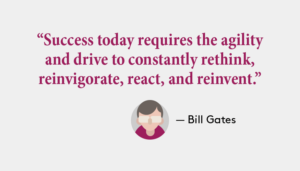Your reasons for choosing to implement ERP software were likely to streamline operations, improve efficiency and achieve greater productivity. But is your ERP still working for you? Or are you working for it?
You probably spent lots of time and resources choosing the right ERP software for your business. And once you deployed it and trained your employees, you should have seen an immediate improvement in communication, smoother business operations and productivity. But after a while, you may have started to notice subtle changes that indicate the ERP system isn’t working for you anymore.
Here we provide some tips for keeping your ERP software working for you.
1. Training
Good quality training is one of the best ways to achieve employee buy-in for your ERP system, and when you first deployed it, you are likely to have trained up all your staff on how to use it. But how much of this do they remember?
If you have noticed a reduction in ERP use, and an increase in the use of other systems, then this could be a key sign that your staff are in need of some refresher training. With an integrated ERP solution, there shouldn’t be a need to rely on separate software programs or spreadsheets. But sometimes it’s hard to break old habits and when an employee doesn’t know how to use the new ERP, they may return to old software.
Refresher training can help them use the system more efficiently, learn about any new functionality, and stop them from going back to old programs or spreadsheets. It can also be an opportunity to cross-train them on related functionality.
It’s also likely that you now have new employees who have only learned the system through on-the-job training, and would benefit from some official training.
2. Ensure senior staff members are still using the system
It’s important to make sure that senior staff members are still using the system as they should be. This shows your employees that the system provides benefit across the entire organisation and sets a good example. If staff members see that their managers are no longer using the system correctly, then they are likely to follow suit.
3. Regularly review the system
You should make sure that the system is regularly reviewed and performing well. Take the time to regularly speak to users of the system – ask them how they are finding it, what’s working, and what they are finding difficult. You can then provide extra training if necessary.
You will probably want to make adjustments to the system as your employees get used to it. They will use it differently after a year than they did when they were newly trained. Ask your employees for suggestions on how to enhance the system’s functionality. By speaking to these knowledgeable users and adapting accordingly, you’ll get more out of your solution.
This is also where an ERP partner can come in handy (see #4). They should be able to provide you with a system health check which includes a review of your use of the new software and ideas for optimisation.
4. Use a local ERP partner
Using an ERP implementation partner allows you to forge a long-term relationship that can optimise your use of the ERP. However, even if you didn’t use a partner for the initial implementation, you can still use a partner going forward for system updates, optimisation and training.
A partner takes care of many of the technical details for you, helping provide peace of mind that your ERP project will be an ongoing success. They can help in the following ways:
- Less disruption to your business – your partner will have the experience and know-how to help make any updates / changes to the system go as smoothly as possible.
- Ongoing training & support – guarantees your business receives the right level of training and support to help you and your staff make the most of your software, for as long as you need it.
- Software health check – a partner can regularly review your company’s use of the technology to make sure it’s meeting your business goals, and suggest ideas for improvement.
- Recommendations to extend functionality – they can provide advice on how to extend the functionality of the software and recommend customisation strategies.
5. Don’t fall behind with software updates
In order to keep your ERP solution working efficiently and providing the expected business benefits that you paid for, you need to have a plan for system updates or you risk having your ERP system eventually become obsolete.
One of the key elements of ERP maintenance is keeping abreast of upgrades from your vendor. These updates contain important bug fixes and security patches, plus they keep your solution from getting out of date. If you don’t keep on top of the upgrades, then your system can become out of date which means you’re not taking advantage of the latest features and innovations.
This is something that you don’t have to worry about if you have NetSuite or another cloud-based ERP. With cloud ERP software, the vendor takes care of all upgrades, which are delivered automatically via the internet. However, if your ERP system is on-premise or even hosted, then you need to have a plan in place to keep on top of system updates.
If your ERP software is hosted, then your upgrades are usually taken care of for you, but this isn’t always the case. You should make sure that this something your hosting provider is doing, otherwise you will need to arrange for your system updates to be carried out.
If your system is on-premise, then it is down to you. Without a maintenance plan, the efficiency of your system will decline and its lifespan will be shortened.
6. Keep on top of equipment maintenance
Another way to ensure your ERP software is working efficiently is to have an equipment maintenance plan in place.
Again, this is something that you don’t have to worry about if you have NetSuite or another cloud-based ERP since you don’t have any servers or related hardware to maintain. However, if your ERP system is on-premise, then you need to have plan in place to keep on top of your equipment maintenance.
Hardware can decrease in efficiency or wear out; you should keep a close eye on it to see if there’s been a drop off in performance. If the technology requires maintenance, then it may affect the performance of your ERP software.
It might also be that there is now new technology on the market that can really improve your ERP solution’s efficiency or effectiveness. This is why you should review your hardware needs and capabilities on a regular basis.
7. Review any business changes
You should carry out an annual review of your business, its needs, and how it has changed so you can ensure that your ERP solution is keeping up.
If your ERP solution can’t keep up with these changes, your employees will develop ways to get their desired results by working around it and using other programs and spreadsheets. This diminishes the efficiency of the system, so it is something you should address.
Software and process adjustments will likely be needed over time, so it’s important to develop and maintain a continuous improvement strategy.
You’ll get most value from your ERP with a continuous improvement plan in place that allows you to adapt to changes in your business and avoid your employees having to find workarounds.
I hope you find this walkthrough useful when trying to keep your own ERP software working for you. Please go ahead and share your own experiences in the comments box below.
NoBlue provides NetSuite ERP which is ideal for growing businesses and larger companies. If you’d like any further information, please get in touch with us!
Image courtesy of bluebay at FreeDigitalPhotos.net









